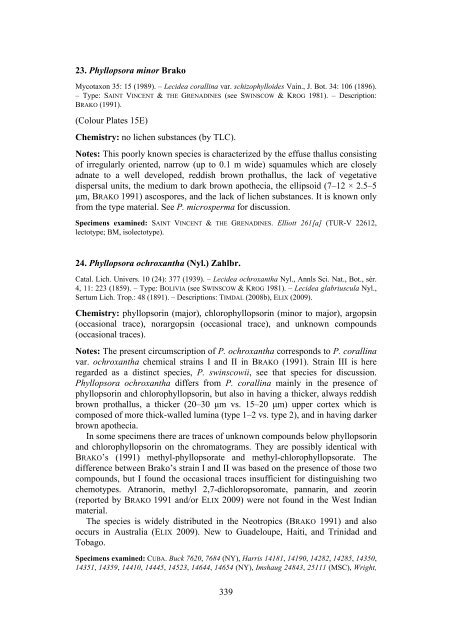A Lichenological Legacy – Festschrift Thomas H
A Lichenological Legacy – Festschrift Thomas H
A Lichenological Legacy – Festschrift Thomas H
Create successful ePaper yourself
Turn your PDF publications into a flip-book with our unique Google optimized e-Paper software.
23. Phyllopsora minor Brako<br />
Mycotaxon 35: 15 (1989). <strong>–</strong> Lecidea corallina var. schizophylloides Vain., J. Bot. 34: 106 (1896).<br />
<strong>–</strong> Type: SAINT VINCENT & THE GRENADINES (see SWINSCOW & KROG 1981). <strong>–</strong> Description:<br />
BRAKO (1991).<br />
(Colour Plates 15E)<br />
Chemistry: no lichen substances (by TLC).<br />
Notes: This poorly known species is characterized by the effuse thallus consisting<br />
of irregularly oriented, narrow (up to 0.1 m wide) squamules which are closely<br />
adnate to a well developed, reddish brown prothallus, the lack of vegetative<br />
dispersal units, the medium to dark brown apothecia, the ellipsoid (7<strong>–</strong>12 × 2.5<strong>–</strong>5<br />
μm, BRAKO 1991) ascospores, and the lack of lichen substances. It is known only<br />
from the type material. See P. microsperma for discussion.<br />
Specimens examined: SAINT VINCENT & THE GRENADINES. Elliott 261[a] (TUR-V 22612,<br />
lectotype; BM, isolectotype).<br />
24. Phyllopsora ochroxantha (Nyl.) Zahlbr.<br />
Catal. Lich. Univers. 10 (24): 377 (1939). <strong>–</strong> Lecidea ochroxantha Nyl., Annls Sci. Nat., Bot., sér.<br />
4, 11: 223 (1859). <strong>–</strong> Type: BOLIVIA (see SWINSCOW & KROG 1981). <strong>–</strong> Lecidea glabriuscula Nyl.,<br />
Sertum Lich. Trop.: 48 (1891). <strong>–</strong> Descriptions: TIMDAL (2008b), ELIX (2009).<br />
Chemistry: phyllopsorin (major), chlorophyllopsorin (minor to major), argopsin<br />
(occasional trace), norargopsin (occasional trace), and unknown compounds<br />
(occasional traces).<br />
Notes: The present circumscription of P. ochroxantha corresponds to P. corallina<br />
var. ochroxantha chemical strains I and II in BRAKO (1991). Strain III is here<br />
regarded as a distinct species, P. swinscowii, see that species for discussion.<br />
Phyllopsora ochroxantha differs from P. corallina mainly in the presence of<br />
phyllopsorin and chlorophyllopsorin, but also in having a thicker, always reddish<br />
brown prothallus, a thicker (20<strong>–</strong>30 μm vs. 15<strong>–</strong>20 μm) upper cortex which is<br />
composed of more thick-walled lumina (type 1<strong>–</strong>2 vs. type 2), and in having darker<br />
brown apothecia.<br />
In some specimens there are traces of unknown compounds below phyllopsorin<br />
and chlorophyllopsorin on the chromatograms. They are possibly identical with<br />
BRAKO’s (1991) methyl-phyllopsorate and methyl-chlorophyllopsorate. The<br />
difference between Brako’s strain I and II was based on the presence of those two<br />
compounds, but I found the occasional traces insufficient for distinguishing two<br />
chemotypes. Atranorin, methyl 2,7-dichloropsoromate, pannarin, and zeorin<br />
(reported by BRAKO 1991 and/or ELIX 2009) were not found in the West Indian<br />
material.<br />
The species is widely distributed in the Neotropics (BRAKO 1991) and also<br />
occurs in Australia (ELIX 2009). New to Guadeloupe, Haiti, and Trinidad and<br />
Tobago.<br />
Specimens examined: CUBA. Buck 7620, 7684 (NY), Harris 14181, 14190, 14282, 14285, 14350,<br />
14351, 14359, 14410, 14445, 14523, 14644, 14654 (NY), Imshaug 24843, 25111 (MSC), Wright,<br />
339<br />
eschweizerbart_xxx

















